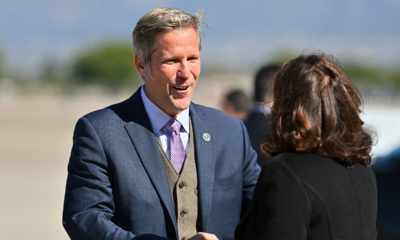Indiana
'Blow the whistle': Indiana's top election official spends $35k on security guide mailings • Indiana Capital Chronicle

You’ve got mail!
Hundreds of election administrators, lawmakers, law enforcement officers and others across Indiana — and beyond— slit open heavy white cardboard boxes this spring to uncover glossy election security guides from the state’s top election official, Secretary of State (SOS) Diego Morales.
“Blow the whistle on election interference,” the thick, spiral-bound books read. They’re accompanied by whistles strung on lanyards.
The 180-page document, per SOS spokeswoman Lindsey Eaton, is “a new addition to the library of election guides produced and distributed by the state for election administrators.”
Assembling and shipping 600 guides cost a whopping $35,070. That’s $58.45 each.
Each booklet cost about $45 to print, and each lanyard with whistle and card was about $1.45, according to Eaton. Packing and shipping cost approximately $12 per guide. SOS paid for the initiative with a 2023 State Homeland Security Grant.
“Secretary Morales firmly believes there’s no price tag when it comes to the safety of our election workers,” Eaton said in written responses to a Capital Chronicle inquiry. She highlighted Morales’ three months of visits to all of the state’s 92 counties and said he’d heard “safety concerns” from the election officials he met on the way.
Poll threats and harassment
Ahead of the 2022 midterm election, rural and urban election officials alike told the Capital Chronicle they’d heard negative comments but not threats and harassment.
But abuse appears to be on the rise.
In a national survey of more than 900 election officials released this month, 38% of the officials reported having experienced abuse, harassment or threats because of their election work. That was up from 30% in 2023, according to the left-leaning Brennan Center for Justice, which conducts the surveys.
Of the 16% who specifically said they’d been threatened — defined as expressions communicating an intention to harm or injure that imply imminent risk to a person’s well-being and safety — more than half said the threats were made in person. They also came in over the phone, email, social media, snail mail and more, according to the survey.
Seven in 10 respondents said they felt threats against election officials have increased since 2020, the same share as in 2023.
Indiana office-holders are paying attention.
State lawmakers approved legislation in March making it a Level 6 felony to threaten an election worker as well as to obstruct, interfere with, or injure an election worker. As for SOS?
“Leading up to the November General Election, (Morales) continues to place a major emphasis on keeping poll workers and election administrators safe,” Eaton wrote. “The election security guides and materials were designed to encourage threat awareness and informed election security and safety collaboration and response between election administrators and allied resources including state and federal emergency response agencies, local law enforcement, and local emergency response agencies.”
That’s why local law enforcement agencies, county emergency management offices, state and federal emergency management offices, were among the recipients.
In addition to county clerks and election administration offices, the office also sent guides to state lawmakers, Indiana’s congressional delegation, the U.S. Election Assistance Commission, members of the National Association of Secretary of States Election Committee and the Voting System Technical Oversight Program (VSTOP) at Ball State University. VSTOP tests all the election equipment used in Indiana.
What’s inside
The guide is a “compilation of materials from authoritative sources,” including the U.S. Department of Homeland Security’s Cybersecurity and Infrastructure Security Agency, four state agencies, a county election board and the Committee for Safe and Secure Elections. Law enforcement and election officials created the latter in 2022 to address violence against election workers and voters.
Just below its list of sources and acknowledgements, however, the guide warns readers the information inside may not be correct.
“This publication is a collection of materials from cited sources. It is presented for education and illustrative purposes and is not intended to be relied on as a legal resource, definitive guidance or administrative directive,” it says. “The State of Indiana does not warrant, and assumes no liability that the information contained herein is complete, up to date, correct, or applicable in any particular situation or circumstance.”
Need to get in touch?
Have a news tip?
“Election administrators, election workers, and persons responsible for safe, secure, and reliable elections are advised to consult with their own legal, security, and public safety advisers about specific situations and actions,” it continues.
The document, which has 18 sections, takes on polling place security plans, election infrastructure security, election worker attacks, suspicious election mail, doxing, swatting, artificial intelligence, photo identification and more.
“The focus of the program is on election worker and voter safety, election security, and state election administration as a component of ‘National Critical Infrastructure,’” Eaton said. “The guide and materials are part of the Secretary of State’s multi-dimensional 2024 program for election safety and security which also includes production of audio-visual training materials, regional training and collaboration seminars, and production and hosting of web accessible election security information.”
It’s not public, however. Eaton said it “has not yet” been published online. High printing costs mean there aren’t physical copies available for everyday residents “at this time,” she added.
SOS photocopied the first four pages of the guide, embedded below, in response to the Capital Chronicle’s inquiry.
2024 Blow the Whistle on Election Interference introduction 5-8-24
GET THE MORNING HEADLINES DELIVERED TO YOUR INBOX

Indiana
Indiana tourism surges past pre-pandemic levels in 2024

INDIANAPOLIS (WNDU) – Indiana tourism surged past pre-pandemic levels in 2024, according to a new report released by Gov. Mike Braun.
The report shows 83 million visitors traveled to Indiana in 2024, a 1.9% increase from 2023. Visitor spending increased 4.7% from the previous year, totaling $16.9 billion and fully recovering to pre-pandemic levels.
Visitors spent an average of $203 each during their stays. For every dollar spent by visitors, 65 cents stayed in Indiana, according to the report.
“Our state’s record tourism year is great news for Hoosiers and proof of just how much there is to love about visiting Indiana,” Braun said. “Tourism means jobs, stronger Main Streets, and economic growth. These results show that our investments are yielding returns for our economy and showing what makes Indiana a great place to live, work, play and stay.”
To view the full Rockport Analytics report, click here.
Copyright 2025 WNDU. All rights reserved.
Indiana
Indiana faces Milwaukee, aims to halt 5-game skid

Milwaukee Bucks (11-18, 11th in the Eastern Conference) vs. Indiana Pacers (6-23, 14th in the Eastern Conference)
Indianapolis; Tuesday, 7:30 p.m. EST
BETMGM SPORTSBOOK LINE: Bucks -1; over/under is 220.5
BOTTOM LINE: Indiana will try to stop its five-game slide when the Pacers take on Milwaukee.
The Pacers are 2-5 against opponents in the Central Division. Indiana has a 3-14 record in games decided by 10 or more points.
The Bucks are 3-4 against Central Division opponents. Milwaukee ranks fifth in the NBA averaging 15.0 made 3-pointers per game while shooting 39.9% from downtown. AJ Green leads the team averaging 3.1 makes while shooting 46.8% from 3-point range.
The Pacers average 109.7 points per game, 7.2 fewer points than the 116.9 the Bucks allow. The Bucks average 15.0 made 3-pointers per game this season, 3.4 more made shots on average than the 11.6 per game the Pacers give up.
The teams square off for the second time this season. The Bucks won the last matchup 117-115 on Nov. 4, with Giannis Antetokounmpo scoring 33 points in the win.
TOP PERFORMERS: Pascal Siakam is averaging 23.8 points, 6.7 rebounds and four assists for the Pacers. Ethan Thompson is averaging 3.0 made 3-pointers over the last 10 games.
Ryan Rollins is averaging 17 points, 5.9 assists and 1.6 steals for the Bucks. Kevin Porter Jr. is averaging 3.0 made 3-pointers over the last 10 games.
LAST 10 GAMES: Pacers: 3-7, averaging 108.9 points, 41.1 rebounds, 23.1 assists, 7.3 steals and 6.1 blocks per game while shooting 44.6% from the field. Their opponents have averaged 114.9 points per game.
Bucks: 3-7, averaging 108.0 points, 39.2 rebounds, 26.2 assists, 8.1 steals and 3.4 blocks per game while shooting 48.0% from the field. Their opponents have averaged 113.7 points.
INJURIES: Pacers: Obi Toppin: out (foot), Ben Sheppard: day to day (calf), Isaiah Jackson: day to day (head), Aaron Nesmith: out (knee), T.J. McConnell: day to day (knee), Tyrese Haliburton: out for season (achilles).
Bucks: Giannis Antetokounmpo: out (calf), Taurean Prince: out (neck).
___
The Associated Press created this story using technology provided by Data Skrive and data from Sportradar.
Indiana
Indiana basketball vs. Siena score, live updates, highlights today

Indiana basketball (9-3) finishes nonconference play with a visit from Siena (9-3) out of the MAAC tonight. The Hoosiers are 6-0 against mid-majors, while this is the Saints’ first game against a power conference opponent.
We will have score updates and highlights throughout, so please remember to refresh.
What time does Indiana basketball play Siena tonight, Dec. 22? Start time for Indiana basketball vs Siena tonight, Dec. 22
The Indiana-Siena game is scheduled for 6 p.m. ET tonight, Dec. 22, at Simon Skjodt Assembly Hall in Bloomington, Indiana.
Where to watch Indiana basketball vs. Siena tonight, Dec. 22? What channel is the Indiana-Siena college basketball game tonight, Dec. 22?
TV: BTN
Watch college basketball with a free Fubo trial
How much are IU basketball tickets tonight? Indiana basketball tickets vs. Siena tonight, Dec. 22
IU basketball tickets on StubHub
Zach Osterman, IndyStar: Indiana 84-62
“Indiana’s second-half power outage Saturday felt like an aberration, at least in games like this. Siena, though, might not necessarily be a walk-over opponent. The Hoosiers should win comfortably, but any pre-holiday malaise might make their last nonconference game uncomfortable. “
Where to listen to Indiana basketball vs. Siena tonight, Dec. 22
As of Dec. 21
- 0, Jasai Miles
- 1, Reed Bailey
- 2, Jason Drake
- 3, Lamar Wilkerson
- 4, Sam Alexis
- 5, Conor Enright
- 6, Tayton Conerway
- 7, Nick Dorn
- 10, Josh Harris
- 11, Trent Sisley
- 12, Tucker DeVries
- 13, Aleksa Ristic
- 15, Andrej Acimovic
(all times ET; with date, day of week, location and opponent, time, TV)
- Sun., Jan. 4: vs. Washington, 8 p.m., BTN
- Wed., Jan. 7: at Maryland, 6:30 p.m., BTN
- Sat., Jan. 10: vs. Nebraska, noon, BTN
Want more Hoosiers coverage? Sign up for IndyStar’s Hoosiers newsletter. Listen to Mind Your Banners, our IU Athletics-centric podcast, on Apple Podcasts, Spotify or wherever you get your podcasts. Watch the latest on IndyStar TV: Hoosiers.
-

 Iowa1 week ago
Iowa1 week agoAddy Brown motivated to step up in Audi Crooks’ absence vs. UNI
-

 Maine1 week ago
Maine1 week agoElementary-aged student killed in school bus crash in southern Maine
-

 Maryland1 week ago
Maryland1 week agoFrigid temperatures to start the week in Maryland
-

 New Mexico7 days ago
New Mexico7 days agoFamily clarifies why they believe missing New Mexico man is dead
-

 South Dakota1 week ago
South Dakota1 week agoNature: Snow in South Dakota
-

 Detroit, MI1 week ago
Detroit, MI1 week ago‘Love being a pedo’: Metro Detroit doctor, attorney, therapist accused in web of child porn chats
-

 Health1 week ago
Health1 week ago‘Aggressive’ new flu variant sweeps globe as doctors warn of severe symptoms
-

 Maine7 days ago
Maine7 days agoFamily in Maine host food pantry for deer | Hand Off

























